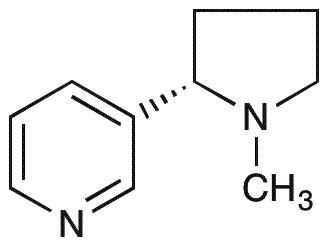(-)-Nicotine is widely utilized in research focused on
- Pharmacology: It serves as a key compound in studying addiction and withdrawal symptoms, helping researchers develop better treatments for nicotine dependence.
- Neuroscience: Used to investigate the effects of nicotine on neurotransmitter release, aiding in understanding cognitive functions and potential therapeutic applications for neurodegenerative diseases.
- Agriculture: Employed in developing natural pesticides due to its insecticidal properties, offering an eco-friendly alternative to synthetic chemicals.
- Flavoring: Incorporated in certain food products and e-liquids for its distinct flavor profile, catering to consumer preferences in the vaping industry.
- Medical Research: Explored for its potential benefits in treating conditions like Alzheimer’s disease, as studies suggest it may enhance memory and attention.
General Information
Properties
Safety and Regulations
Applications
(-)-Nicotine is widely utilized in research focused on
- Pharmacology: It serves as a key compound in studying addiction and withdrawal symptoms, helping researchers develop better treatments for nicotine dependence.
- Neuroscience: Used to investigate the effects of nicotine on neurotransmitter release, aiding in understanding cognitive functions and potential therapeutic applications for neurodegenerative diseases.
- Agriculture: Employed in developing natural pesticides due to its insecticidal properties, offering an eco-friendly alternative to synthetic chemicals.
- Flavoring: Incorporated in certain food products and e-liquids for its distinct flavor profile, catering to consumer preferences in the vaping industry.
- Medical Research: Explored for its potential benefits in treating conditions like Alzheimer’s disease, as studies suggest it may enhance memory and attention.
Documents
Safety Data Sheets (SDS)
The SDS provides comprehensive safety information on handling, storage, and disposal of the product.
Product Specification (PS)
The PS provides a comprehensive breakdown of the product’s properties, including chemical composition, physical state, purity, and storage requirements. It also details acceptable quality ranges and the product's intended applications.
Certificates of Analysis (COA)
Search for Certificates of Analysis (COA) by entering the products Lot Number. Lot and Batch Numbers can be found on a product’s label following the words ‘Lot’ or ‘Batch’.
*Catalog Number
*Lot Number
Certificates Of Origin (COO)
This COO confirms the country where the product was manufactured, and also details the materials and components used in it and whether it is derived from natural, synthetic, or other specific sources. This certificate may be required for customs, trade, and regulatory compliance.
*Catalog Number
*Lot Number
Safety Data Sheets (SDS)
The SDS provides comprehensive safety information on handling, storage, and disposal of the product.
DownloadProduct Specification (PS)
The PS provides a comprehensive breakdown of the product’s properties, including chemical composition, physical state, purity, and storage requirements. It also details acceptable quality ranges and the product's intended applications.
DownloadCertificates of Analysis (COA)
Search for Certificates of Analysis (COA) by entering the products Lot Number. Lot and Batch Numbers can be found on a product’s label following the words ‘Lot’ or ‘Batch’.
*Catalog Number
*Lot Number
Certificates Of Origin (COO)
This COO confirms the country where the product was manufactured, and also details the materials and components used in it and whether it is derived from natural, synthetic, or other specific sources. This certificate may be required for customs, trade, and regulatory compliance.


